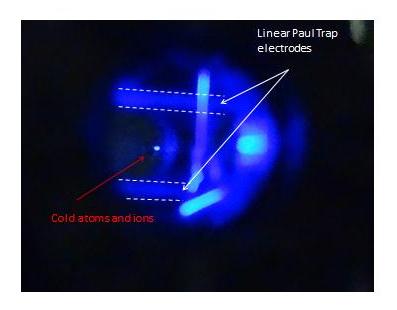Nov 27 2012
Among the most important techniques developed in atomic physics over the past few years are methods that enable the storage and cooling of atoms and ions at temperatures just above absolute zero. Scientists from Bangalore and Mainz have now demonstrated in an experiment that captured ions can also be cooled through contact with cold atoms and may thus be stored in so-called ion traps in a stable condition for longer periods of time. This finding runs counter to predictions that ions would actually be heated through collisions with atoms.
 The bright spot next to the laser light projected on the electrodes of the ion cage and other surfaces is where the captured ions and atoms overlap Photo/©: Raman Research Institute
The bright spot next to the laser light projected on the electrodes of the ion cage and other surfaces is where the captured ions and atoms overlap Photo/©: Raman Research Institute
The results obtained by the joint Indo-German research project open up the possibility of conducting future chemical experiments to generate molecular ions at temperatures as low as those that prevail in interstellar space.
Scientists of the Raman Research Institute in the Bangalore in India and the Institute of Physics at Johannes Gutenberg University Mainz (JGU) in Germany combined two techniques for their experiment. They captured neutral atoms in a magneto-optic trap, cooled them with laser light to a temperature close to absolute zero at minus 273.15 degrees Celsius, and also stored charged particles in an ion trap. For this purpose, Professor Dr. Günter Werth had to set a Paul trap as used in Mainz in India, where it was combined with a magneto-optic trap. It was thus possible to trap ions and cold atoms at one and the same location to observe their development.
"The question was whether it would work at all," explains Werth. The experiment with rubidium ions and rubidium atoms then showed that the particles did actually exchange energy. The ions were effectively cooled during a collision with the cold atoms. As the scientists write in their article in Nature Communications, there are two fundamental processes that determine the outcome. During continuous cooling, the atoms indirectly extract energy from the trapped ions. In addition, the collision between ions and atoms causes both to exchange their charges and results in the transformation of a 'hot' ion into a 'cold' ion. As it is possible to maintain a constant concentration of atoms in the reservoir of the magneto-optic trap, the system has the capacity to cool a larger number of ions without immediate exhaustion of the atom reservoir.
The interaction between ions and atoms is particularly interesting to physicists because it is thought that similar interactions might also occur in the coldness of outer space. "The expectation is that the interaction of ions and atoms at very low temperatures will result in the formation of molecular ions. This is a process that we believe also occurs in inter-stellar space," says Werth.